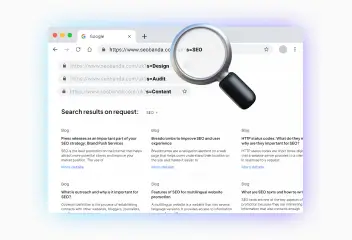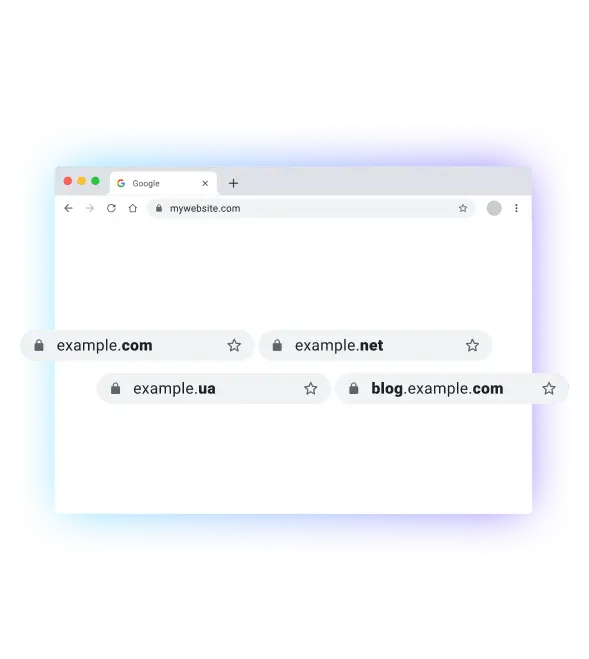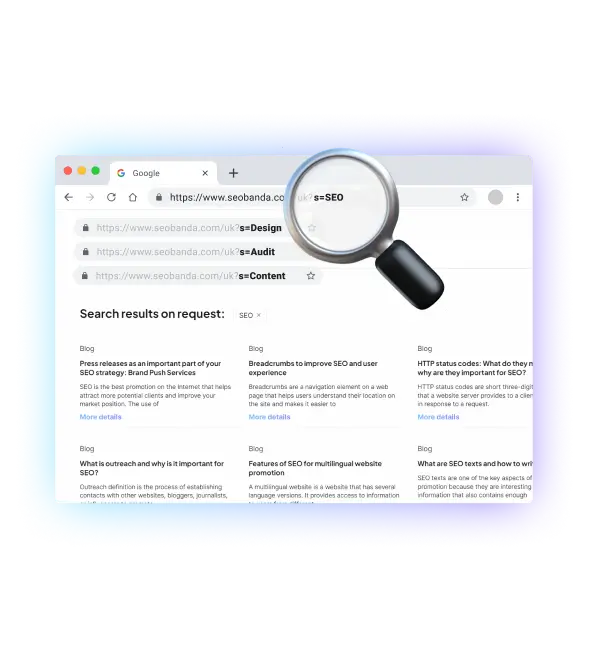

What is a domain name?
A domain name is the name of a website on the Internet. If you enter it into a search engine, the user will immediately see your site, because two different resources cannot have the same name. A domain plays a very important role in the creation and promotion of a website, affecting its visibility, recognition, and reputation.
A domain name consists of two parts: the name and the domain zone. For example, let’s take the domain “example.com”, in this case “example” is the name and “.com” is the domain zone.


How do domain names work?
When a user enters a domain name into a search engine, it contacts the DNS (Domain Name System), which translates that name into an IP address (a unique set of numbers that represents the hosting on which the website is hosted). This allows users to access a website by a convenient textual address, instead of complex numeric IP addresses.

Increase visibility
for your business: SEO solution for growth!


Types of domain names
There are several basic types of domain names:
- Top-level domain (TLD): This is a general category that includes domains such as .com, .org, .net. This type also includes country domains, such as .ua, .us, etc.
- Second-level domain: this is the main part of the domain name that comes before the TLD, for example, in “example.com” it is “example”.
- Third-level domain: a subdomain added before the main second-level domain, for example, “blog.example.com”.
The first and second types of domain are always used together, but the third type is optional and is usually used only when creating a large number of sites with similar domain names.


Comparison of domain names. Advantages and disadvantages of different domains

- Generic gTLDs:
- For example: .com, .org, .net
- Advantages: The .com domain is the most common and well-known domain associated with commercial websites, so it increases the visibility of your website. Users also trust domains with the .com or .org extension more. Another advantage is global reach. Such sites are suitable for an international audience and promotion to the whole world, but you need to take care of the multilingualism of the site so that it is convenient for all users.
- Disadvantages: Many good .com domains are already taken, so this limits the availability of such names. The second is the cost. Some popular TLDs may be more expensive than others.
- Specialized TLDs:
- For example: .edu, .gov, .museum.
- Advantages: Immediately reflect the activity of the site (for example, when you see .edu, you immediately realize that this site is engaged in education or educational institutions). Also, people are a little more trusting when they notice such domains, because they better understand the content of the site and build their expectations.
- Disadvantages: The first disadvantage is the limitation. Only certain organizations and institutions can register such domains. This also negatively affects recognition, as they are aimed at a specific audience.
- Country code top-level domains (ccTLDs):
- For example: .ua, .uk, .de.
- Advantages: Localization is great for businesses that are focused on a specific country and have physical locations or stores. It also gives a significant advantage in local SEO.
- Disadvantages: Due to the limited audience reach, such domains are not suitable for international projects and companies. Also, ccTLDs have some restrictions and requirements for registration.
- New generic top-level domains (new gTLDs):
- For example: .shop, .blog, .tech.
- Advantages: The ability to choose a more unique and creative domain name increases the chance that it will be remembered by users. Also, such domains have more free names, as they are in lower demand and are aimed at a narrower focus.
- Disadvantages: Such domains are quite new, and this can negatively affect trust from people and search engines (it takes time to gain trust). Also, new domains are less well known among the general public and have a negative impact on brand awareness.


Why is a domain name important for SEO?
A website’s domain name is a very important part of its life. That is why it plays an important role in website optimization:
- First impressions of users: the domain name is the first thing users notice when interacting with your brand online. How easy it is to remember determines whether users will return to your website and whether they will ever remember your brand.
- Keywords in the domain name: having relevant keywords in your domain name can have a positive impact on SEO. Although the influence of this factor decreases over time, it can still help improve your site’s position and visibility in search results.
- Trust and credibility: users and search engines have more trust in well-known and reliable domain names.
- Local SEO: country TLDs can improve your site’s position in specific geographic markets, as search engines recognize that your site is focused on that particular region.
- Branding: A unique, interesting, and simple domain name helps to create a strong brand and increase traffic to your website. Users will be more likely to enter well-known domains directly in the browser, thus increasing the level of direct and general traffic.
- Social signals: If your brand name is interesting and on the lips of the public, it promotes more active sharing of content on social networks. This has a positive effect on social signals that are taken into account when ranking a website.
- Backlinks: other sites are more likely to link to your resource if its name is professional, authoritative, and interesting. High-quality link building is one of the main ranking factors and directly affects the website’s position.
- Avoiding filters and sanctions: using domain names with a bad reputation or those associated with spam can lead to sanctions from search engines. You should choose high-quality domains that will help you avoid such problems.


How to register a domain name?

Domain name registration is an important step in creating a website and building an online reputation. Here is a step-by-step guide on how to set up a domain:
Step 1: Choose a domain name:
- Branding: choose a name that is easy to remember, relevant to your brand and activities.
- Keywords: it is advisable to consider including relevant keywords if they are appropriate.
- Shortness: the domain name should be short and easy to type.
- Avoiding symbols: avoid using hyphens and numbers if possible. They can be difficult to remember.
Step 2: Check accessibility:
- Check for availability: Use domain name registrar services (e.g. GoDaddy, Namecheap, or Ukrainian services such as Ukrnames) to check if your chosen domain name is available.
- Alternatives: If your name is taken, consider other domain zones (e.g., .net, .org) or choose a similar name.
Step 3: Choose a registrar:
- Price comparison: Check the prices of different registrars, you may find one cheaper and have better conditions.
- Services: Some registrars offer additional services, such as domain privacy, web hosting, email, and others.
Step 4: Register the domain name:
- Account: Create an account with the registrar of your choice.
- Domain selection: Add the selected domain name to your cart.
- Additional options: Select additional options such as domain privacy if required.
- Payment: Complete the payment for domain registration. Remember that registration is usually for a year with the possibility of renewal.
Step 5: Set up the domain:
- DNS settings: Specify the DNS servers of your hosting provider in the domain settings so that your site is hosted exactly where you need it.
- Redirects: If you have multiple domains, you need to set up redirects to the main domain.
Step 6: Confirmation of registration:
- Confirmation email: Most registrars will send you an email to confirm your domain registration. Be sure to confirm the registration.
Step 7: Setting up your website:
- Web hosting: Connect the domain to your web host.
- SSL certificate: Install an SSL certificate for a secure connection (HTTPS).
- Install CMS: Install a content management system (e.g. WordPress) if required.
Registering a domain name is not a simple but very important process. Choosing the right name and a reliable registrar will help you lay a solid foundation for your website and brand.

Increase visibility
for your business: SEO solution for growth!


Conclusion
A website’s domain name is its name on the Internet. This element affects brand awareness and some parts of SEO (which in turn can improve or worsen the site’s position). There are several types of domain names that are suitable for different cases (.com, .ua, .blog, etc.). You have also learned how to set up a domain name, but if you couldn’t do it yourself, don’t hesitate to contact SEObanda, we will help!
You may also like it

Brand identity: The key to brand recognition and SEO success
Every product has its own unique feature that sets it apart from other brands. It could be a special font, a unique mascot, or an interesting logo with the right...

What is a dynamic URL and its impact on SEO
A dynamic URL (Uniform Resource Locator) is a web address that changes depending on the user's request or specific parameters. It differs from a static














